#folk saint
Text
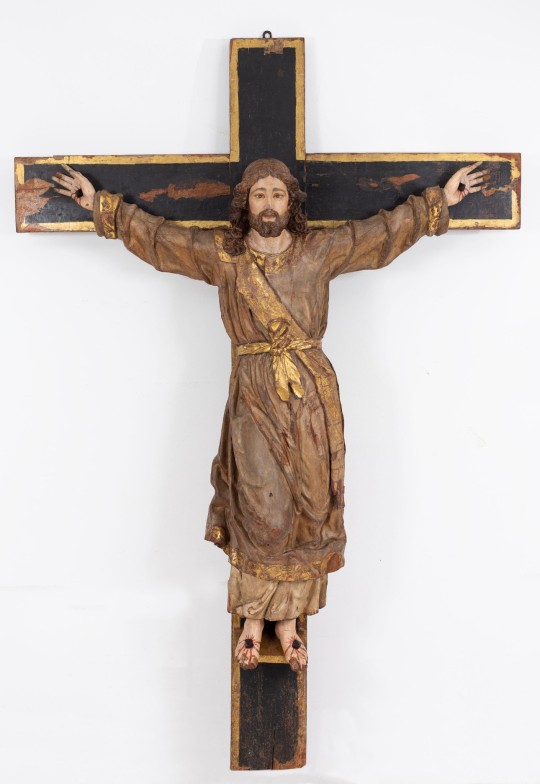
When Catalonia's National Art Museum (MNAC) acquired this piece, they thought it represented Jesus Christ on the cross. On a closer study, they realised it represents a woman: Saint Wilgefortis (Santa Lliberada in Catalan, which means "Saint Liberated").
This wooden sculpture was made by an artist called Andreu Sala around the year 1689 for the church of El Carme in Barcelona, Catalonia. But why does a female saint have a beard? This is not a shock to anyone familiar with this saint's story.
According to the legends, Wilgerfortis was the daughter of a pagan king of Portugal. She converted to Christianity in secret and made a vow of chastity. Her father gave her hand in marriage to a pagan or Moorish king, but she refused to marry anyone. To avoid marriage, she prayed to God to disfigure her to make men find her ugly. God answered her prayers and blessed her by making her grow a beard. The marriage was broken and that made her father angry. He accused Wilgerfortis of witchcraft and had her crucified, like Christ had been.
There are different hypothesis about the origin of this legend:
Some say it might be related to ancient intersex divinities, such as the Ancient Greek Hermaphroditus.
Others say it might have its origin in a side-effect of malnourishment that many nuns had. In convents, it was very common to fast (=not eat for long periods of time for religious reasons), so many nuns had hormonal imbalances that can result in growing facial hair.
The most widespread hypothesis seems to be that Saint Wilgerfortis and similar legends were created to re-interpret the Christs in Majesty that culturally didn't seem male anymore. Because of Byzantine influence, in the Romanesque period (11th-13th centuries), sometimes Christ on the Cross was represented wearing a long tunic tied at the waist and looking calm. After that period, Christ on the Cross was always represented half naked and suffering. They are so different that they look like different saints and the long dress fitted at the waist was associated with women at the time, so people who saw the old representations of Christ would assume it was a woman with a beard, and came up with legends to explain the beard.

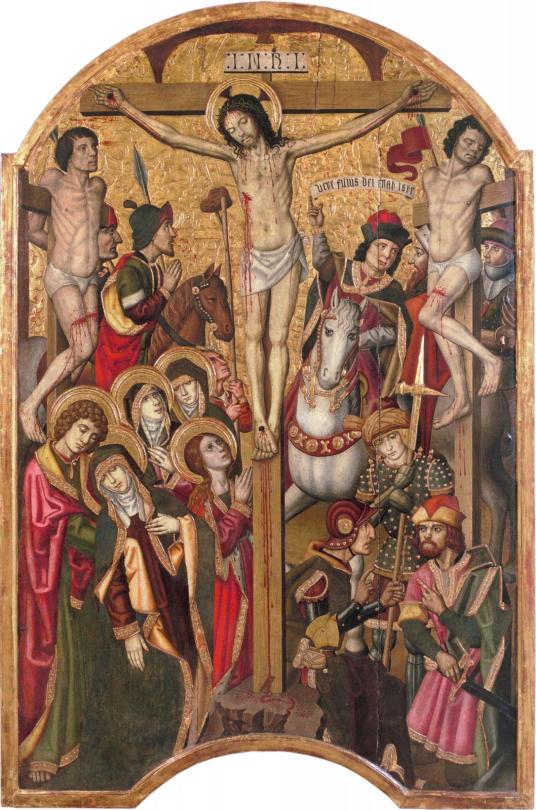
Here you can compare the two ways of representing Christ. On the left, the statue called Majestat Batlló, made in the 1100s in la Garrotxa (Catalonia) in Romanesque style. On the right, the Calvari painting made around 1470 in Granollers (Catalonia). Both of them are kept in MNAC.
There are some other saints with very similar stories to Saint Wilgefortis, like Saint Múnia of Barcelona.
Now you might be wondering, how do we know this statue represents Saint Wilgefortis and not Christ? First of all, this statue is from the Baroque period, where Christ was never represented wearing a long tunic and hadn't been for centuries. Culturally, it would not make any sense for a Catalan artist in the 1600s to represent Christ or any normative man wearing what by then was a woman's dress. Secondly, if you look at the statue from the side, you can see that she has some boobs. And lastly, when the statue was restored, they found a textile fragment at the bottom of the tunic, which was a stitching work made from lace. Traditionally, lace has been a type of decoration used in women’s clothing.
So there is no doubt that this statue, like others that can be found all around Europe, represents Saint Wilgefortis. The woman who was blessed with a beard, and who we call Saint Liberated because her beard liberated her.
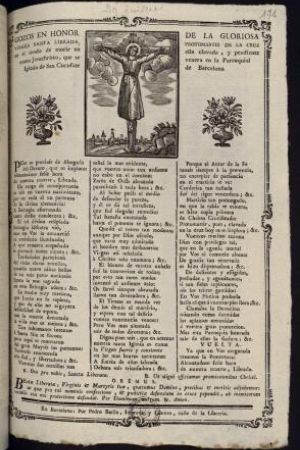

Couplets in honour of Saint Wilgefortis for the church Sant Cugat del Rec in Barcelona, Catalonia. 18th century. Source: Mediateques Montpellier. Here, the images represent her without a beard, but the poem explains her story.
Traditionally, Saint Wilgefortis has been patron saint of agriculture, travellers, children who were stunted or had difficulty walking, skin diseases, pets, laundresses, and the agony of the dying. In more recent times, two more were added: Saint Wilgefortis is the patron saint of transgender people and has been claimed as a lesbian martyr.
Source: Museu Nacional d'Art de Catalunya.
#arts#escultura#uselesslgbtfacts#mnac#baroque#saint wilgefortis#folk saint#trans#transgender#intersex#art history#trans history#museums#museum#history#història#catholiscism#catholic#eating disorder mention#religion
134 notes
·
View notes
Note
Do in some cases folk saint is closed practiced like saint kali sara
I have heard of Saint kali Sara, she is a Romani Saint who has origins of the Hindu Goddess called Kali Ma and highly venerated by Romani people in many regions/countries like Spain and France(mainly southern France) and other countries, but I don’t know if she is closed or not. Since I am not Romani it’s best to ask if she is closed or not. But since it’s general question and Kali Sara is an example of a folk saint being closed yes sometimes folk saints are closed.
#bruja#taino#arawak#brujasoftumblr#spirituality#tainoarawak#brujeria#kali sara#saint Kali sara#folk saint#Romani
7 notes
·
View notes
Text
Introduction to Sara la Kali, Saint of displaced people.

Sara la Kali is the patron saint of the Romani people. She is venerated primarily in Saintes-Maries-de-la-Mer, a town in the Camargue region of southern France, which is a significant pilgrimage site for the Roma community.
Her domain as a saint consists of displaced people, refugees, migrants, people who were/are oppressed & the Romani people. She is a symbol of hope for the oppressed.

According to her legend, Sara was a servant of the three Marys (mainly her mother, Mary Magdalene), who helped them (with the help of an angel) to arrive in France by a small boat, fleeing persecution of Christians after Jesus' death. She is also said to be Jesus' secret daughter, hidden from the patriarchy for her safety.
In one legend, Sara supported the Marys by begging while they were busy teaching Christianity to the locals. In another legend, when the Marys were still on their journey and caught in a storm at sea, Sara spread her cloak to save them.
Yet another legend has it that Sara was not a servant, but a Roma queen who already lived in the south of France and welcomed the arrival of the Marys and Christianity.
In another version, there were more people on the boat: Mary Salome, Lazarus, Joseph of Arimathea, and Jesus' followers, who set out to sea in the small boat with no oars, sails, food, or water.
This is where Sara comes in. In this version, Sara was a maid to Mary Jacob. As the small boat carrying her mistress drifted out to sea, Sara was deeply heartbroken, thinking she had been left behind in a land devastated by war & persecution. When Mary Jacob saw Sara distraught and crying, she threw her cloak over the waves. Sara grabbed it and was pulled into the boat with the others.

Where did she come from?: When the Romani people were persecuted and forced to convert to Christianity, they blended their indigenous Hindu beliefs with Christian practices, creating a form of syncretism. The romani at that time were mostly Shakta Hindus, and worshipped the goddess Kali-ma.
Since Kali-ma was so important to them, they transformed/disguised her as a Christian saint, and called her “Sara Kali”. Sara is a blending of different traditions, Kali-ma and the Black Madonnas/marys.
Another thing that traces back to her origin as a dharmic goddess is her halo, which is the dharmachakra (wheel of the law).

Sara shares traits with other Black Madonnas and dark, feminine divinities in Latin America, the Caribbean, Africa, etc. She is often called "black mother" (just like Kali-ma's name, which literally translates to that).
the Roma have been persecuted as unwelcome migrants from India, facing violence wherever they go. Despite this, their patron Saint Sara has provided hope and identity to the more than 12 million members of the Roma diaspora around the world.
Every year, thousands of Roma gather in Saintes-Maries-de-la-Mer to honor her with a procession and various rituals. In one of her rituals, She is immersed in the water just as the Hindu goddess Durga is every year in India. The Romani venerate her as their queen, but she is also a mother to all the local Catholics who feel a connection to her.
Sara Kali's personal veneration by the Romani brings cures of sickness, good luck, fertility, success in business ventures, and protection.
Other names/titles she goes by: Saint Sarah, Saint Kali, Sara E Kali, black mother, Mother of the Romani, secret child of Jesus, sati-Sara, Queen of the Romani, protector of the oppressed, brown sara, sara the black, Sarah the Egyptian

Ave Sara La Kali... mother of the Romani
#sara kali#Sara e kali#Sara la kali#christianity#Saint#folk Saint#romani#Hinduism#Shaktism#sanatandharma#religion#kali#kali ma#kalika#Devi#Devi kali#maa kali#syncretism#displaced people
4 notes
·
View notes
Text

Santa Muerte by Kypris Aquarelas
#santa muerte#pagan#paganism#folk catholicism#catholicism#christian#christianity#virgin mary#la niña#la niña blanca#Nuestra Señora de la Santa Muerte#la Santa Muerte#holy death#death#mexican#saint#folk saint#deity#shadow work#Our Lady of Holy Death#saint death#Mictlancihuatl#Lady of Shadows#Bony Lady#skeleton#esqueleto#day of the dead#dia de los muertos#watercolours
23 notes
·
View notes
Photo

#Jesús Malverde#Narcosaint#El Chapo Guzman#Jesús Juarez Matzo Campos#folklore#narco-saint#Mexican state of Sinaloa#Sinaloa#Spanish heritage#folk saint#Mexico#Robin Hood
26 notes
·
View notes
Link

Over 60 years ago, a little Cajun Catholic farm girl died in agony of leukemia. A lot of people believe that she is a saint
By Rod Dreher
12 notes
·
View notes
Text

“were you waiting for me in bed?”
from the latest chapter of @morningstarwrites fic “Of Saints and Sinners”
#radioapple#osas#of saints and sinners#duckiedeer#my art#i did this in a rush i’m so sorry#yes i’m gonna do the damn closet scene#don’t worry folks
1K notes
·
View notes
Text

A Saint, from the 'Jackdaw of Rheims' by Briton Rivière
#briton rivière#briton riviere#art#jackdaw#rheims#saint#the ingoldsby legends#poem#english#england#cardinal#ring#bird#birds#jackdaws#corvus#corvid#corvids#crow#crows#raven#ravens#europe#legends#books#necklace#rosary#european#folk tales#folklore
550 notes
·
View notes
Text
I think one of the most powerful tools a practitioner can use in ritual, though not one I see discussed often, is reenactment.
Reenacting the myths of your gods.
Reenacting the trials of your saints.
Reenacting the movement and rhythm of the natural world around you.
To act as these is to invoke these, body and soul- both from without and within. To feel the exact space that they occupy in the ritual, which is yourself. It is to clothe yourself in their divinity, so that a small part shall remain.
This is the spell, you see. That piece, that part, is the gift imparted to you. To shape you or guide you in the way you ask.
#magic#folk magic#spirituality#magic practitioners#folklore#ritual magic#sorcery#myths#polytheism#gods#saints
561 notes
·
View notes
Text

Saint Lucian women, Saint Lucia, by ANSE CHASTANET ST.LUCIA
#saint lucian#saint lucia#america#carribean#folk clothing#traditional clothing#traditional fashion#cultural clothing
242 notes
·
View notes
Text
A collection of my favourite Catholic images 🥀🕯
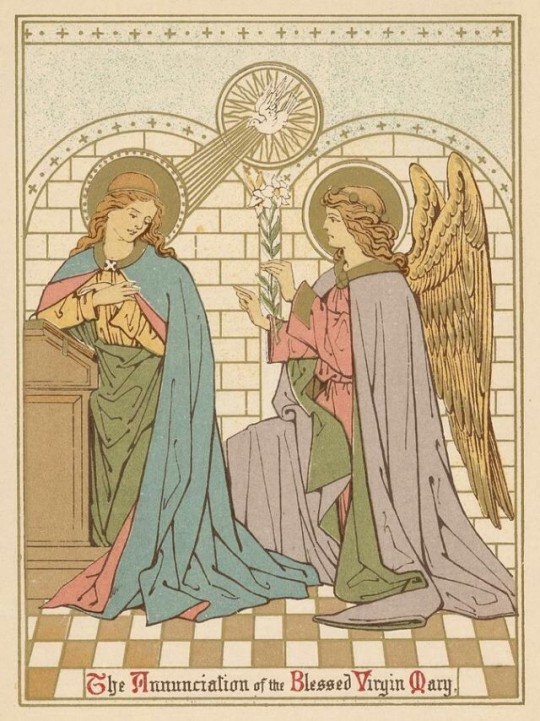
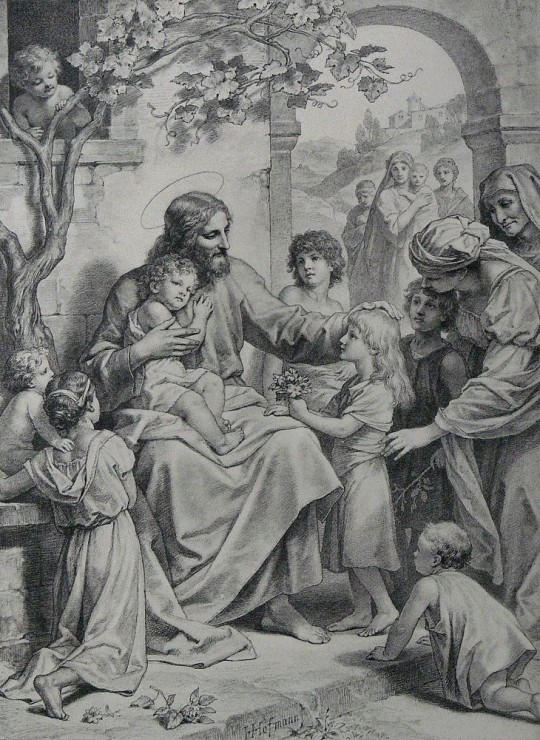
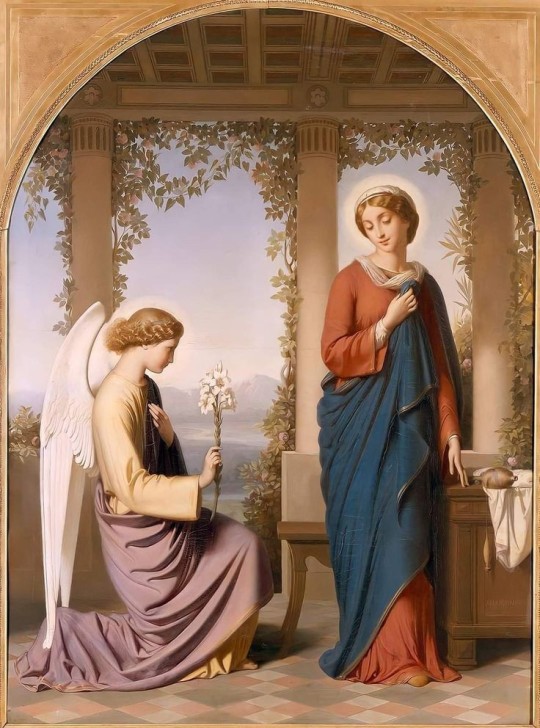
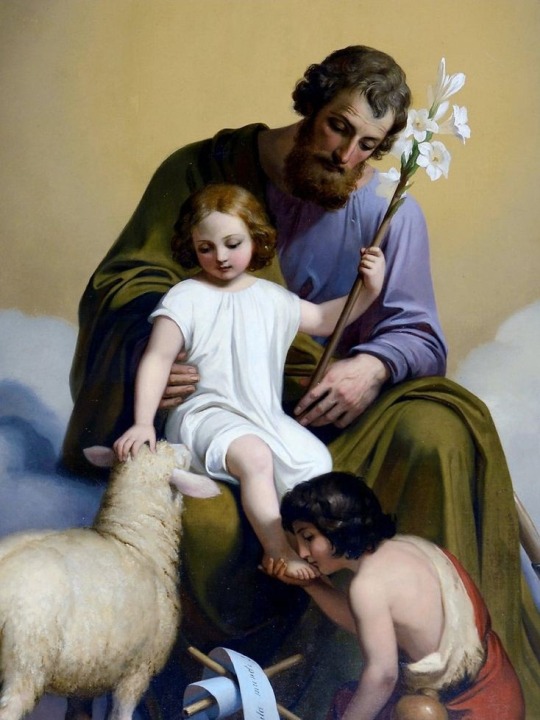
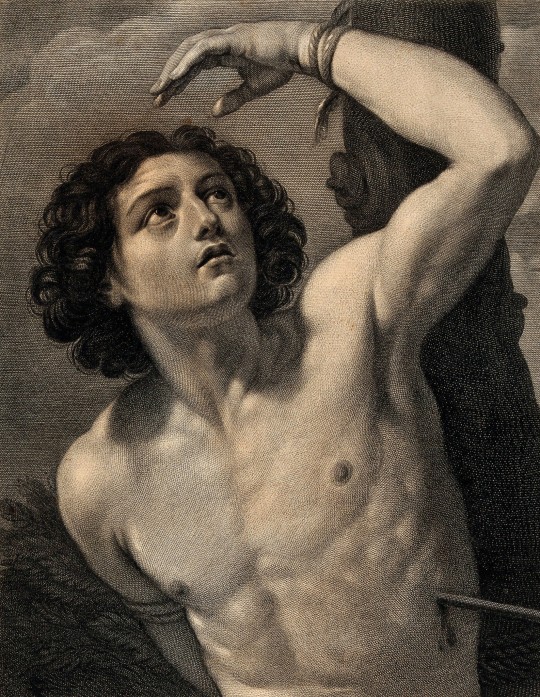


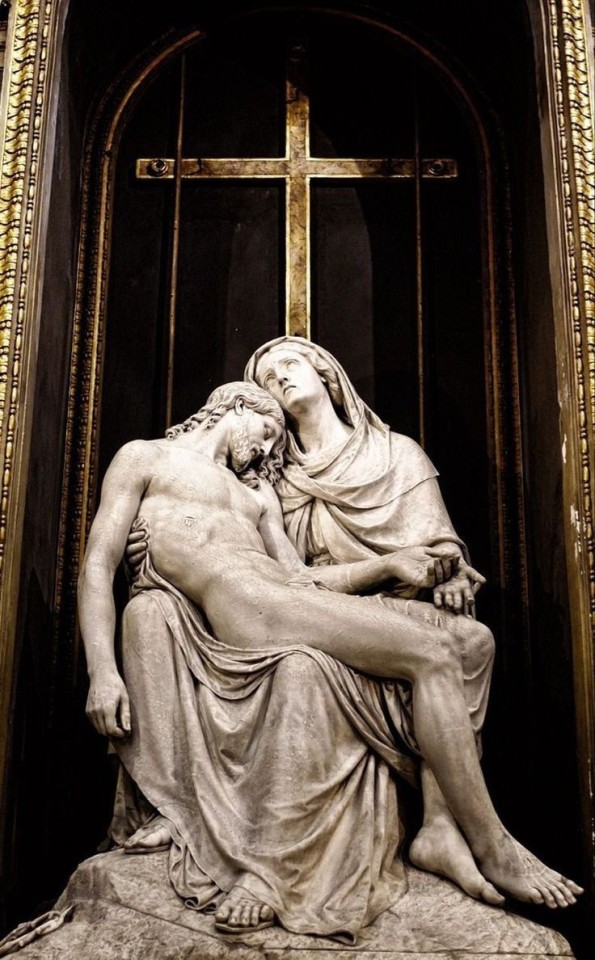


#🥀🕯#christopagan#christopaganism#jesus christ#folk catholic#folk catholicism#christian#catholic#catholiscism#virgin mary#the blessed virgin mary#mother mary#saint joseph#saint gabriel#saint sebastian#saint michael#faith
100 notes
·
View notes
Text




Joan Hears the Voices – Luc-Olivier Merson // Actress Amanda Linder as Joan of Arc – Christian Wilhelm Allers // Illustration from La Normandie – Alfred Johannot // Illustration from Personal Recollections of Joan of Arc – Frank DuMond // Pray – The Amazing Devil
#aaannnd we are back folks!!#starting off strong with some joan posting and tad posting 🫡🫡#joan of arc#jeanne d'arc#saint joan of arc#pray#pray song#pray tad#pray the amazing devil#love run#love run album#love run tad#love run the amazing devil#the amazing devil#tad#joey batey#madeline hyland#art#art history#lyrics#lyric art
182 notes
·
View notes
Text
So it was established in the last episode that Taylor still believes in Santa (tbh I wouldn't be surprised if it's come up prior to this ep too but anyways-) so... Do you think (saint) Nicky been has portalling in every year since the betrayal to sneak in a gift for his son amongst the pile? That Cassandra doesn't even notice because it's just one among the many many presents she herself has bought and wrapped? But every year without fail... Taylor gets one gift that simply says "from: Nick" and well, obviously that has to mean it's from Santa (a conclusion which Nicky expects him to come to, and why he can sign his name at all, though he misses when he could just write "dad"). And one year when he's still quite young, a sleepy little Taylor actually catches Nicky in the act, and Nicky wishes more than anything that he could just *stay*, but instead he only softly tells Taylor to go back to bed, and Taylor thinks that Santa is a lot younger and a bit sadder than he expected, but what's he gonna do- not listen to Santa Claus? So he smiles meekly at the man he does not know to be his father, and hurriedly heads back to his room.
Also yes of course Nicky eats the fucking cookies left out of course he's not gonna pass up on free cookies (which are home-baked to top it off) come on that's a given.
#at my conspiracy board like ''he sees you when you're sleeping... he knows when you're awake- just like Nicky watching Taylor from Hell!''#dndads#dungeons and daddies#nick foster#I'm sure I mustn't be the only person who's proposed a headcanon to this effect but anyways in light of recent events!#and Taylor asks Nicky what kind of cookies he likes and Nicky says ''oatmeal raisin'' and Taylor says ''gross''#but insists on putting those ones out next year and every year after that#nicky freeman#taylor swift dndads#highkey knowing Nicky and the dumbass shenanigans he gets wrapped up in he would do something to accidentally become the real santa claus#like he shows up to the wrong house one year and gets spotted#so then in his mind he has to show up to *both* houses next year#but then the kid from the other house tells all their friends#and what is he gonna do- not get gifts for all of them too? that wouldn't be fair.#you see where I'm going with this?#dndads holiday special starring Nicky in the tale of how he became saint nick#I won't lie to you folks the Closes and Swifts are basically the only reason I care at all about this holiday haha#(though happy holidays to all of you celebrating- whatever you're celebrating!)#''but you're hosting a holiday event!'' YEAH AND LOOK WHO IT'S FOR LOL#(back at my conspiracy board) santa... is just an anagram for satan... it all makes sense!
189 notes
·
View notes
Text

#brigid devotee#devotional blog#irish pagan#goddess brigid#digital altar#saint brigid#brigid goddess#folk catholicism#folk witch#folk magic
82 notes
·
View notes
Text




Medieval wood carving and a modern stone counterpart of St. Procopius who, legend has it, plowed a field with the chained devil- Prague, Czechia
#folklore#gothic#occult#folk horror#devil#demon#imp#plow#saint#st. procpopius#religion#legend#myth#prague#czech republic#czechia#stone carving#wood carving#folk art
331 notes
·
View notes
Text

good boy, saint guinefort!
prints here
#Just realized I never posted this piece on tumblr#this is a travesty.#if you don't know about Saint Guinefort he was a dog who became a folk saint in medieval france#hound#hunting dog#art#illo#artists on Tumblr#perpetually thinking about sainthood and martyrdom
80 notes
·
View notes